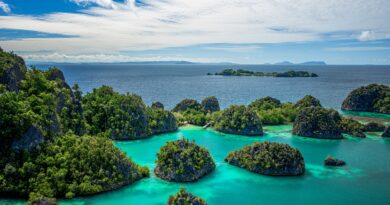Balancing Economic Growth and Environmental Sustainability in Indonesia
In international economic development, a prevailing perspective often regards environmental degradation as an inevitable “cost” that must be paid to secure Indonesia’s perceived “benefits” of economic growth. This trade-off principle raises a critical ethical question: must the Indonesian government adhere strictly to a dichotomy where the choice is limited to prioritizing “economic development” or “environment?”? The acceptance of such a dichotomy prompts contemplation on whether the Indonesian government should consider putting the brakes on “the economic growth pedal” to impede resource exploitation and mitigate environmental degradation as its commitment to the Paris Agreement.
Since 1968, global efforts to address climate change have intensified. Establishing the Intergovernmental Panel on Climate Change marked a pivotal moment, leading to international cooperation initiatives like the Paris Agreement. Over 150 countries, including Indonesia, have committed to reducing emissions significantly by 2030 and achieving net-zero emissions by 2060 to limit global warming to 1.5 degrees Celsius while also considering sustainable economic growth.
Economic Development in Indonesia
As a developing country, Indonesia remains focused on bolstering its economic growth to generate more employment opportunities for its increasing population. Based on data from Indonesia’s statistics, the average economic growth in Indonesia over the last decade has been around 5%, with a GDP per capita in 2022 of approximately USD 4,700. Indonesia aspires to become a developed country by 2045, meaning it must sustain a minimum economic growth of 6%-7% until 2045.
Indonesia’s national statistical agency also indicates that the country’s population is projected to increase by 20% by 2045, accompanied by substantial urbanization. In economics, population growth can increase the labor force, thereby fostering economic growth. Consequently, population growth implies the nation needs more resources to prevent poverty and have essential utilities such as electricity.
However, to support the enhanced productivity and anticipate the increased energy demand, Indonesia predominantly relies on fossil fuels, making up 87.7% of production, and low-carbon energy sources contributing a mere 12.3%, leading to a substantial rise in Indonesia’s Carbon dioxide (CO2) emissions. This association aligns with the GHG emissions report of all world countries in 2023, where Indonesia’s total CO2 emissions continue to increase from 160.85 metric tons of CO2 (1990) to 692.24 metric tons of CO2 (2022).[1] To enhance the capacity of these low-carbon energy sources, Indonesia requires a substantial investment of approximately USD 600 billion. Depending solely on the State Budget (2023: around USD 200 billion) creates a funding gap.
Net Zero Emissions Commitment
Climate change can increase the risk of hydrometeorological disasters, where about 80% of total disasters in Indonesia are attributed to climate change, and estimated to pose a potential economic shock for Indonesia, ranging from a 0.66% to 3.45% reduction in GDP by 2030. In response to this threat, Indonesia joined international efforts in 2016 to keep the rate of global warming far below 1.5 degrees Celsius. In the Enhanced Nationally Determined Contribution 2022 document, the Indonesian government has pledged to achieve net-zero emissions by 2060 and to reduce the intensity of its greenhouse gas emissions by 41% by 2030.
Economic Development at What Cost?
One measure that can gauge a country’s progression and modernity is energy consumption per capita, which is the energy used to perform an activity, inhabit a building, or produce and manufacture something. According to the Ministry of Energy and Mineral Resources, Indonesia’s electricity consumption per capita in 2023 reached 1,285 kilowatt-hours (kWh). For Indonesia to be considered “advanced,” its electricity consumption must arrive at least around 4,000-5,000 kWh per capita, requiring Indonesia to have a minimum power generation capacity of 300-400 Gigawatts, compared to the current 81 Gigawatts.
Referring to calculations by the Indonesian State-Owned Electricity Company, an investment of up to USD 600 billion is needed to increase the capacity of power plants based on renewable energy by 2060. Given the limited Indonesian state budget, external investments are necessary to cover these costs. Additionally, even if such investments are successfully attracted to Indonesia, another issue is the purchasing power of most Indonesians is only around USD 0.3-0.5 per kWh (coal energy source). Meanwhile, for the investment to be profitable, the sale of electricity from renewable energy per kWh must be around USD 0.6-0.11 per kWh, double what current Indonesians pay. This dissonance between green investment requirements and consumer affordability paints a troubling picture, where only the elite few can afford it rather than wider Indonesians.
The Role of Government Policies
Recent macroeconomic research on developing countries indicates that under the high-emission scenario, total factor productivity (including labor, human capital, and physical capital) may decline by 2.6 to 4.0 percentage points. To mitigate this issue, the Indonesian government, as custodians of public welfare and stewards of natural resources, should play a central role in shaping this dynamic relationship. In navigating this intricate landscape, Indonesia stands at a crossroads where environmental considerations must guide policy choices. The role of government policies, encompassing fiscal measures, carbon taxation, and urban planning, emerges as a crucial lever in steering Indonesia to achieve a balance between economic development and environmental sustainability. While challenges remain, acknowledging the sustainability dimension in the trade-off between economic growth and environmental preservation reflects a growing awareness of the need for fair and responsible decision-making. By embracing innovative and inclusive strategies, Indonesia has the potential to reconcile economic aspirations with environmental imperatives, ensuring a sustainable path forward.
Biography of Author
Ardyansah is pursuing a Master of Public Policy degree at the Gerald R. Ford School of Public Policy at the University of Michigan, with the expected concentration in Public Policy Analysis Methods.
Edited By: Allison Hanley, MPP 2024 // Eneida Hysi, MPP 2024





